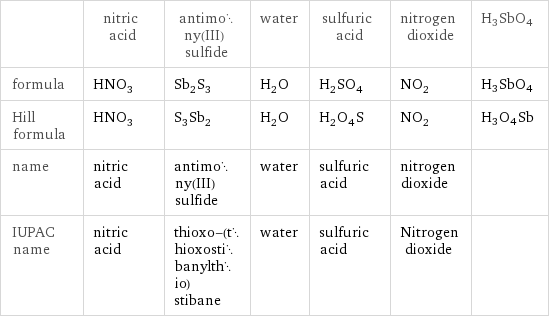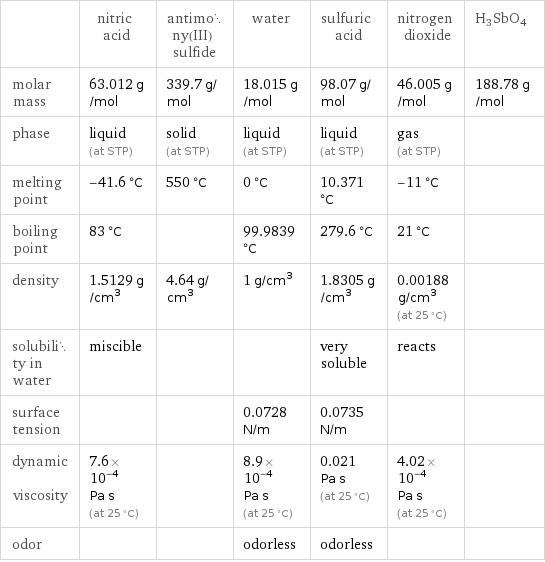Input interpretation

HNO_3 nitric acid + Sb_2S_3 antimony(III) sulfide ⟶ H_2O water + H_2SO_4 sulfuric acid + NO_2 nitrogen dioxide + H3SbO4
Balanced equation

Balance the chemical equation algebraically: HNO_3 + Sb_2S_3 ⟶ H_2O + H_2SO_4 + NO_2 + H3SbO4 Add stoichiometric coefficients, c_i, to the reactants and products: c_1 HNO_3 + c_2 Sb_2S_3 ⟶ c_3 H_2O + c_4 H_2SO_4 + c_5 NO_2 + c_6 H3SbO4 Set the number of atoms in the reactants equal to the number of atoms in the products for H, N, O, S and Sb: H: | c_1 = 2 c_3 + 2 c_4 + 3 c_6 N: | c_1 = c_5 O: | 3 c_1 = c_3 + 4 c_4 + 2 c_5 + 4 c_6 S: | 3 c_2 = c_4 Sb: | 2 c_2 = c_6 Since the coefficients are relative quantities and underdetermined, choose a coefficient to set arbitrarily. To keep the coefficients small, the arbitrary value is ordinarily one. For instance, set c_2 = 1 and solve the system of equations for the remaining coefficients: c_1 = 28 c_2 = 1 c_3 = 8 c_4 = 3 c_5 = 28 c_6 = 2 Substitute the coefficients into the chemical reaction to obtain the balanced equation: Answer: | | 28 HNO_3 + Sb_2S_3 ⟶ 8 H_2O + 3 H_2SO_4 + 28 NO_2 + 2 H3SbO4
Structures

+ ⟶ + + + H3SbO4
Names

nitric acid + antimony(III) sulfide ⟶ water + sulfuric acid + nitrogen dioxide + H3SbO4
Equilibrium constant
![Construct the equilibrium constant, K, expression for: HNO_3 + Sb_2S_3 ⟶ H_2O + H_2SO_4 + NO_2 + H3SbO4 Plan: • Balance the chemical equation. • Determine the stoichiometric numbers. • Assemble the activity expression for each chemical species. • Use the activity expressions to build the equilibrium constant expression. Write the balanced chemical equation: 28 HNO_3 + Sb_2S_3 ⟶ 8 H_2O + 3 H_2SO_4 + 28 NO_2 + 2 H3SbO4 Assign stoichiometric numbers, ν_i, using the stoichiometric coefficients, c_i, from the balanced chemical equation in the following manner: ν_i = -c_i for reactants and ν_i = c_i for products: chemical species | c_i | ν_i HNO_3 | 28 | -28 Sb_2S_3 | 1 | -1 H_2O | 8 | 8 H_2SO_4 | 3 | 3 NO_2 | 28 | 28 H3SbO4 | 2 | 2 Assemble the activity expressions accounting for the state of matter and ν_i: chemical species | c_i | ν_i | activity expression HNO_3 | 28 | -28 | ([HNO3])^(-28) Sb_2S_3 | 1 | -1 | ([Sb2S3])^(-1) H_2O | 8 | 8 | ([H2O])^8 H_2SO_4 | 3 | 3 | ([H2SO4])^3 NO_2 | 28 | 28 | ([NO2])^28 H3SbO4 | 2 | 2 | ([H3SbO4])^2 The equilibrium constant symbol in the concentration basis is: K_c Mulitply the activity expressions to arrive at the K_c expression: Answer: | | K_c = ([HNO3])^(-28) ([Sb2S3])^(-1) ([H2O])^8 ([H2SO4])^3 ([NO2])^28 ([H3SbO4])^2 = (([H2O])^8 ([H2SO4])^3 ([NO2])^28 ([H3SbO4])^2)/(([HNO3])^28 [Sb2S3])](../image_source/702e88dec9061a68418c2234b13c51be.png)
Construct the equilibrium constant, K, expression for: HNO_3 + Sb_2S_3 ⟶ H_2O + H_2SO_4 + NO_2 + H3SbO4 Plan: • Balance the chemical equation. • Determine the stoichiometric numbers. • Assemble the activity expression for each chemical species. • Use the activity expressions to build the equilibrium constant expression. Write the balanced chemical equation: 28 HNO_3 + Sb_2S_3 ⟶ 8 H_2O + 3 H_2SO_4 + 28 NO_2 + 2 H3SbO4 Assign stoichiometric numbers, ν_i, using the stoichiometric coefficients, c_i, from the balanced chemical equation in the following manner: ν_i = -c_i for reactants and ν_i = c_i for products: chemical species | c_i | ν_i HNO_3 | 28 | -28 Sb_2S_3 | 1 | -1 H_2O | 8 | 8 H_2SO_4 | 3 | 3 NO_2 | 28 | 28 H3SbO4 | 2 | 2 Assemble the activity expressions accounting for the state of matter and ν_i: chemical species | c_i | ν_i | activity expression HNO_3 | 28 | -28 | ([HNO3])^(-28) Sb_2S_3 | 1 | -1 | ([Sb2S3])^(-1) H_2O | 8 | 8 | ([H2O])^8 H_2SO_4 | 3 | 3 | ([H2SO4])^3 NO_2 | 28 | 28 | ([NO2])^28 H3SbO4 | 2 | 2 | ([H3SbO4])^2 The equilibrium constant symbol in the concentration basis is: K_c Mulitply the activity expressions to arrive at the K_c expression: Answer: | | K_c = ([HNO3])^(-28) ([Sb2S3])^(-1) ([H2O])^8 ([H2SO4])^3 ([NO2])^28 ([H3SbO4])^2 = (([H2O])^8 ([H2SO4])^3 ([NO2])^28 ([H3SbO4])^2)/(([HNO3])^28 [Sb2S3])
Rate of reaction
![Construct the rate of reaction expression for: HNO_3 + Sb_2S_3 ⟶ H_2O + H_2SO_4 + NO_2 + H3SbO4 Plan: • Balance the chemical equation. • Determine the stoichiometric numbers. • Assemble the rate term for each chemical species. • Write the rate of reaction expression. Write the balanced chemical equation: 28 HNO_3 + Sb_2S_3 ⟶ 8 H_2O + 3 H_2SO_4 + 28 NO_2 + 2 H3SbO4 Assign stoichiometric numbers, ν_i, using the stoichiometric coefficients, c_i, from the balanced chemical equation in the following manner: ν_i = -c_i for reactants and ν_i = c_i for products: chemical species | c_i | ν_i HNO_3 | 28 | -28 Sb_2S_3 | 1 | -1 H_2O | 8 | 8 H_2SO_4 | 3 | 3 NO_2 | 28 | 28 H3SbO4 | 2 | 2 The rate term for each chemical species, B_i, is 1/ν_i(Δ[B_i])/(Δt) where [B_i] is the amount concentration and t is time: chemical species | c_i | ν_i | rate term HNO_3 | 28 | -28 | -1/28 (Δ[HNO3])/(Δt) Sb_2S_3 | 1 | -1 | -(Δ[Sb2S3])/(Δt) H_2O | 8 | 8 | 1/8 (Δ[H2O])/(Δt) H_2SO_4 | 3 | 3 | 1/3 (Δ[H2SO4])/(Δt) NO_2 | 28 | 28 | 1/28 (Δ[NO2])/(Δt) H3SbO4 | 2 | 2 | 1/2 (Δ[H3SbO4])/(Δt) (for infinitesimal rate of change, replace Δ with d) Set the rate terms equal to each other to arrive at the rate expression: Answer: | | rate = -1/28 (Δ[HNO3])/(Δt) = -(Δ[Sb2S3])/(Δt) = 1/8 (Δ[H2O])/(Δt) = 1/3 (Δ[H2SO4])/(Δt) = 1/28 (Δ[NO2])/(Δt) = 1/2 (Δ[H3SbO4])/(Δt) (assuming constant volume and no accumulation of intermediates or side products)](../image_source/173d296cba45712484a332ad6a97ad83.png)
Construct the rate of reaction expression for: HNO_3 + Sb_2S_3 ⟶ H_2O + H_2SO_4 + NO_2 + H3SbO4 Plan: • Balance the chemical equation. • Determine the stoichiometric numbers. • Assemble the rate term for each chemical species. • Write the rate of reaction expression. Write the balanced chemical equation: 28 HNO_3 + Sb_2S_3 ⟶ 8 H_2O + 3 H_2SO_4 + 28 NO_2 + 2 H3SbO4 Assign stoichiometric numbers, ν_i, using the stoichiometric coefficients, c_i, from the balanced chemical equation in the following manner: ν_i = -c_i for reactants and ν_i = c_i for products: chemical species | c_i | ν_i HNO_3 | 28 | -28 Sb_2S_3 | 1 | -1 H_2O | 8 | 8 H_2SO_4 | 3 | 3 NO_2 | 28 | 28 H3SbO4 | 2 | 2 The rate term for each chemical species, B_i, is 1/ν_i(Δ[B_i])/(Δt) where [B_i] is the amount concentration and t is time: chemical species | c_i | ν_i | rate term HNO_3 | 28 | -28 | -1/28 (Δ[HNO3])/(Δt) Sb_2S_3 | 1 | -1 | -(Δ[Sb2S3])/(Δt) H_2O | 8 | 8 | 1/8 (Δ[H2O])/(Δt) H_2SO_4 | 3 | 3 | 1/3 (Δ[H2SO4])/(Δt) NO_2 | 28 | 28 | 1/28 (Δ[NO2])/(Δt) H3SbO4 | 2 | 2 | 1/2 (Δ[H3SbO4])/(Δt) (for infinitesimal rate of change, replace Δ with d) Set the rate terms equal to each other to arrive at the rate expression: Answer: | | rate = -1/28 (Δ[HNO3])/(Δt) = -(Δ[Sb2S3])/(Δt) = 1/8 (Δ[H2O])/(Δt) = 1/3 (Δ[H2SO4])/(Δt) = 1/28 (Δ[NO2])/(Δt) = 1/2 (Δ[H3SbO4])/(Δt) (assuming constant volume and no accumulation of intermediates or side products)
Chemical names and formulas

| nitric acid | antimony(III) sulfide | water | sulfuric acid | nitrogen dioxide | H3SbO4 formula | HNO_3 | Sb_2S_3 | H_2O | H_2SO_4 | NO_2 | H3SbO4 Hill formula | HNO_3 | S_3Sb_2 | H_2O | H_2O_4S | NO_2 | H3O4Sb name | nitric acid | antimony(III) sulfide | water | sulfuric acid | nitrogen dioxide | IUPAC name | nitric acid | thioxo-(thioxostibanylthio)stibane | water | sulfuric acid | Nitrogen dioxide |
Substance properties

| nitric acid | antimony(III) sulfide | water | sulfuric acid | nitrogen dioxide | H3SbO4 molar mass | 63.012 g/mol | 339.7 g/mol | 18.015 g/mol | 98.07 g/mol | 46.005 g/mol | 188.78 g/mol phase | liquid (at STP) | solid (at STP) | liquid (at STP) | liquid (at STP) | gas (at STP) | melting point | -41.6 °C | 550 °C | 0 °C | 10.371 °C | -11 °C | boiling point | 83 °C | | 99.9839 °C | 279.6 °C | 21 °C | density | 1.5129 g/cm^3 | 4.64 g/cm^3 | 1 g/cm^3 | 1.8305 g/cm^3 | 0.00188 g/cm^3 (at 25 °C) | solubility in water | miscible | | | very soluble | reacts | surface tension | | | 0.0728 N/m | 0.0735 N/m | | dynamic viscosity | 7.6×10^-4 Pa s (at 25 °C) | | 8.9×10^-4 Pa s (at 25 °C) | 0.021 Pa s (at 25 °C) | 4.02×10^-4 Pa s (at 25 °C) | odor | | | odorless | odorless | |
Units
